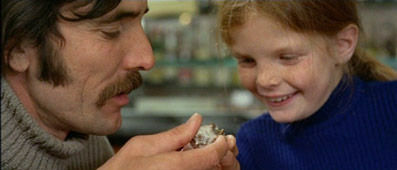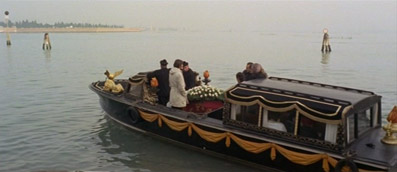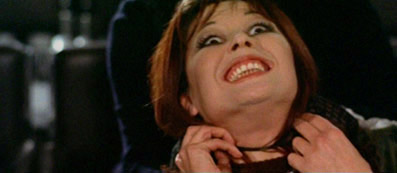|
Remember George Lazenby? He was the only James Bond who was denied a second term, a man whose working relationship with co-star Diana Rigg was inaccurately damned by the tabloid press, who took a throwaway remark about garlic eating and ran with it like the malicious morons they are. In Bondian retrospect, Lazenby does look something of a fall guy. He lacked the effortless on-screen charisma required to fill Connery's shoes, but provided a buffer zone that allowed Roger Moore to step up to the plate without attracting similar brickbats. Poor old George. As it happens, On Her Majesty's Secret Service was a damned good Bond movie, but come Live and Let Die George was replaced by an amiable and very British actor whose limited range prompted Spitting Image to cruelly (but amusingly) inflict a puppet of Timothy Dalton with a paralysing condition known as Roger Mortis.
Normally, such a big screen debut would be seen as an instant career launcher, but not for our George. TV guest roles and undistinguished movies came and went, and George never found the post-Bond success and fame of his fellow 007 actors. But in spite of all that, he did do some interesting work in films that have slipped off the radar in the intervening years. One of the best was made in Italy just three years after the Bond role and was directed by the wonderfully named Aldo Lado, he of the 1975 mystery thriller Night Train Murders [L'Ultimo treno della notte]. His 1972 Who Saw Her Die? [Chi l'ha vista morire?] (also known as The Child) is not only a neat little thriller in its own right, it also eerily foreshadows one of the most celebrated genre works of the modern age.
It kicks off in the ski resort of Megeve in France in 1968, when a young girl runs into the woods and is killed and quickly buried by an unseen figure wearing a black veil. Six years later we're in Venice and Roberta, a girl of similar age and appearance, arrives from London to spend some time with her sculptor dad Franco (that's our George, physically distanced from Bond by his 35 pound weight loss, his big moustache and his 70s haircut). She hangs out with him as he meets with friends and business associates, who include a rotund bohemian journalist whose name I didn't catch, a fencing-scarred ponce of a man named Philip (the English dub of his first line is worth buying this DVD for alone), and a wealthy art dealer (at least I think that's what he does) named Serafian. The last of these is played by Sicilian actor Aldolfo Celli, who also had his moment in the James Bond sun as bad guy Emilio Largo in Thunderball. I'll just bet he and George had loads to talk about.

Franco and Roberta get on famously until Franco gets an itch that only girlfriend Gabriella can scratch and leaves his daughter to play with some local kids so that he can get his end away. The audience has already been clued in to the presence of the murderer from the opening scene via a sequence in which Roberta and a friend are approached by a POV shot with a black veil over the lens, so we're perhaps more sensitive than Franco to the stupidity of his action. But we have to remember this was 1972, a long while before we started locking our kids into barred schools and seeing paedophiles on every street corner, so how was he to know? When Roberta doesn't come home that night, Franco goes in frantic search but finds no trace of her. The next morning, in a beautifully executed reveal, her body washes up in one of the canals. The police have no real clues, and with his estranged wife Elizabeth (Anita Strindberg, a popular figure with genre fans) back at his side, Franco sets out on a quest to find his daughter's killer.
Even if you've not read UK DVD distributor Shameless's pre-publicity blurb (or our own news story on this release), a few of the elements here should ring a bell. Yep, very different films though they may be, the similarities to Nicolas Roeg's seminal Don't Look Now are impossible to ignore. The couple at the story's centre here may be separated, but like the pair in Roeg's film they consist of an English wife and a non-English husband who is involved in the arts. Their daughter is killed at an early stage and is discovered face-down in water, and the pair look for closure in off-season Venice, where there's a murderer on the loose that one of them is destined to face before the film's end. Atmospheric use is made of the Venetian locations, and there's even a brief, cross-cut sex scene here. It's probably stretching it a bit to note that the leading men both have similar facial hair, given its popularity when the films were made. And before you start groaning at the nerve of these rip-off merchants, know that Who Saw Her Die? was released a year before Roeg's film hit the cinemas. Nice one, Aldo.

That's not to say Who Saw Her Die? is as sophisticated or as disturbing as Don't Look Now. As a giallo film, it boasts many of the genre's strengths but also a fair few of its weaknesses. Effectively done false scares involve actions that push credibility (just why did the maid need to fill the bath to clean the bathroom?), red herrings are liberally scattered, and the identity of the killer is kept secret by making it someone you've no reason to suspect and, to be frank, who has no reason to commit the killings in the first place. There's also an hilarious final line that's clearly designed to avoid trouble with the Italian authorities, but one I can't discuss without revealing the ending.
But Who Saw Her Die? is nicely paced, stylishly shot by Franco Di Giacomo and tightly edited by Angelo Curi. It's busy with character detail and potentially relevant sub-plots, makes terrific use of its location, and features a most effective giallo score from one Ennio Morricone (who also scored Night Train Murders), the broken rhythm kiddie chants of the main attack theme giving way to a mournful children's choir on the discovery of Roberto's body, the sequence that most closely approaches Don't Look Now's uniquely unsettling tone. And yes, it delivers on genre expectations, in the spectacular demise of its villain, in a blood-from-the-mouth close-up, and in the violence and visual strangeness of one of the killings, which is carried out with big scissors in front of a private aviary, from which the birds then escape to fly around and settle on the victim's body.
As for our George, he does well and probably a lot better, but it's hard to properly judge when his dialogue was recorded in English, dubbed in Italian and the re-dubbed for this international release in English again. But he's a likeable lead who slots believably into his surroundings, and Who saw Her Die? is a film that showcases his range and appeal well enough for me to wonder why we're still remembering him primarily for a role that may have launched his career, but ultimately did him no favours.
A very nice anamorphic 2.35:1 transfer from Shameless. The picture is almost spotless, the colours vivid without over-saturation, the contrast consistently well balanced and the detail good. Film grain is visible and there are some compression artefacts on areas of single colour, but on the whole this is a sound job.

The mono soundtrack has a slightly restricted dynamic range but is otherwise clear enough, with only a trace of background hiss and no crackle or damage to spoil the suspense.
Just the theatrical trailer (3:01), as ever, and I'm not convinced it's the real deal, but it's nifty enough and makes full use of Morricone's score.
Aldo Lado is proving to be an interesting retrospective find. Night Train Murders was slick but derivative, while Who Saw Her Die? is every bit as well made and foreshadows one of the greatest thrillers of modern times. It's another neat resurrection by Shameless, who after a few months of quiet are back delivering the 70s exploitation goods. No extras of note, but another fine transfer of a worthwhile rediscovery.
|